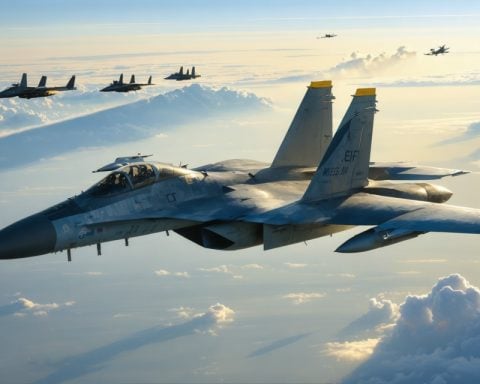- The F-15EX Eagle II is the latest fighter jet developed to replace the aging F-15C/D fleet, costing $90 million per unit.
- It features advanced avionics, digital fly-by-wire controls, and a powerful radar, with the capability to carry 29,500 pounds of weaponry.
- Critics argue the cost is prohibitive, especially given its lack of stealth technology, which is crucial in modern aerial combat.
- The infrastructure required for production adds significant complexity and expense.
- Advocates praise its versatility and adaptability, while opponents question its necessity compared to alternatives like the F-35A.
- The debate centers around whether the F-15EX’s capabilities justify its high costs in today’s defense budget constraints.
The F-15EX Eagle II, the latest marvel in the storied lineage of fighter jets, soars into view with a hefty $90 million price tag. Designed to replace the aging fleet of F-15C/Ds, this new jet promises unparalleled versatility in combat. But behind its gleaming exterior and advanced systems lies a storm of controversy.
Boeing’s creation bristles with cutting-edge features: advanced avionics, digital fly-by-wire controls, and an impressive radar, promising supremacy both in the air and on the ground. Capable of carrying a staggering 29,500 pounds of weaponry, it stands as one of the most heavily armed aircraft in the skies.
Yet, despite these dazzling capabilities, critics remain unconvinced. The price, they insist, is prohibitive—especially when considering the F-15EX’s lack of stealth technology, a crucial feature in today’s airborne operations. They’ve raised eyebrows over the costs not just of acquisition, but of maintenance and operation as well. Building the infrastructure to produce this heavyweight beauty is no small task, adding layers of complexity—and cost—on top of already bloated budgets.
Even as advocates highlight the plane’s adaptability to rapid technological shifts, opposition questions the necessity of such an investment when other aircraft, like the F-35A, offer comparable—or even superior—features. In a world where defense budgets constantly juggle competing priorities, is the F-15EX’s extraordinary firepower truly indispensable?
As debates rage, the F-15EX Eagle II cuts through the sky, embodying both progress and the price of progress. In this high-stakes gamble, the question resounds: Is this leap forward worth the climb in cost, or is it just an expensive twist in an already complex air duel?
Is the High Cost of the F-15EX Eagle II Worth the Tactical Edge?
Features, Specs & Pricing
The F-15EX Eagle II, developed by Boeing, is packed with state-of-the-art technology designed to replace the aging F-15C/D fleet. Priced at approximately $90 million per unit, this aircraft is equipped with:
– Advanced Avionics: Enhances navigational and operational efficiencies.
– Digital Fly-by-Wire Controls: Offers superior maneuverability.
– AN/APG-82(V)1 Radar: Provides exceptional situational awareness and targeting capabilities.
– Weapons Capacity: A payload capacity of 29,500 pounds, making it one of the most heavily armed fighter jets available.
Real-World Use Cases
The adaptability of the F-15EX makes it suitable for various missions:
– Air Superiority Missions: With its impressive radar and armament, the F-15EX can maintain air dominance.
– Ground Attack Operations: Capable of delivering a vast arsenal with precision.
– Homeland Defense: Fast response capabilities make it suitable for defense scenarios.
Market Forecasts & Industry Trends
The fighter jet market is expected to grow as nations modernize their air forces. With geopolitical tensions rising, countries aim to invest in reliable and proven technology:
– A market push for non-stealth aircraft, considering their lower operational costs and proven track records.
– The F-15EX’s capability to accommodate future technological upgrades is a significant industry trend.
– As countries weigh their defense budgets, balancing cutting-edge technology with cost-effectiveness becomes crucial.
Reviews & Comparisons
When compared to the F-35A, the F-15EX faces significant scrutiny:
– F-35A:
– Stealth technology is a major selling point.
– More advanced electronic warfare and intelligence capabilities.
– F-15EX:
– Superior payload capacity.
– Proven reliability with lower development risks.
While the F-15EX offers robust features, many see the lack of stealth as a potential drawback amid growing advanced sensor technology in global aerial warfare.
Controversies & Limitations
The controversies surrounding the F-15EX largely revolve around:
– Cost Concerns: The high acquisition and maintenance costs raise questions about budget allocations.
– Lack of Stealth: Without stealth features, the jet may face vulnerabilities against advanced air defense systems.
Security & Sustainability
– Security Enhancements: The F-15EX’s advanced avionics and radar systems contribute to battlefield superiority.
– Sustainability: Boeing emphasizes the aircraft’s long service life, anticipating 20,000 flight hours. The ease of integrating new technologies ensures its relevance for decades.
Insights & Predictions
Experts predict a balanced approach in future aircraft investments:
– Nations may continue investing in both stealth and non-stealth aircraft.
– Continuous advancements in counter-stealth technologies could level the playing field for non-stealth platforms like the F-15EX.
– The strategic versatility of the F-15EX might justify its cost for nations prioritizing multi-role capabilities.
Pros & Cons Overview
Pros:
– Remarkable firepower and payload capacity.
– Advanced, adaptable technological suite.
– Lower risk profile given its reliance on proven systems.
Cons:
– Expensive initial and long-term investment.
– Lack of stealth could limit operational utility in high-threat environments.
Actionable Recommendations
1. Strategic Allocation: Defense planners should leverage the F-15EX for specific roles where its strengths, such as payload and versatility, can be fully utilized.
2. Future Proofing: Countries should consider additional upgrades or complementary systems to mitigate the lack of stealth.
3. Balanced Procurement: Integrating a mixed fleet could provide a comprehensive defense strategy, leveraging both stealth and traditional capabilities.
For more information on Boeing, visit Boeing’s website.
Navigating the evolving landscape of military aviation requires careful evaluation of both immediate and long-term strategic goals. The F-15EX Eagle II represents a formidable option, albeit one that demands critical consideration of its role within broader defense frameworks.







